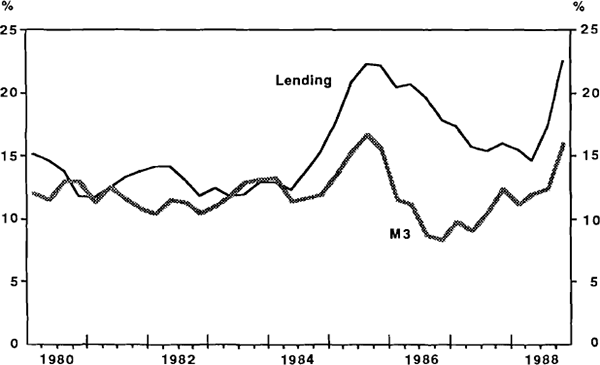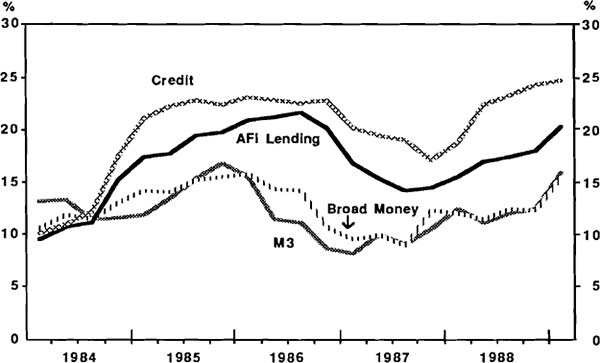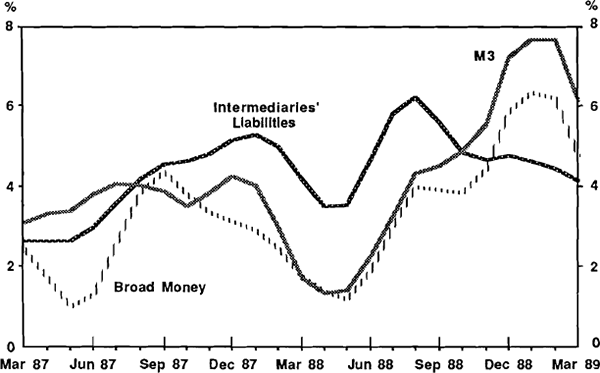RDP 8904: Changes in the Behaviour of Banks and their Implications for Financial Aggregates 4. Changes to SRD Arrangements
July 1989
- Download the Paper 932KB
While there were major changes in the behaviour of banks in the early 1980s because of deregulation, some aspects of banks' behaviour continued to be heavily influenced by remaining pockets of regulation. Indeed, deregulation made it easier for banks to modify their behaviour to take account of remaining regulations.
The main aspect of regulation that continued to have a major impact on banks' behaviour was the Statutory Reserve Deposit requirement (SRD). It acted as an incentive for banks to look for forms of funding other than domestic Australian dollar deposits, and to shift away from direct lending and towards fee-for-service activities such as bill acceptance and endorsement. Both these incentives are borne out by the data for recent years which, up to late 1988, showed extremely rapid growth in bank bills on issue and increased funding by banks through foreign currency and offshore liabilities.
These developments had major implications for monetary and financial aggregates. This is illustrated in Graph 8 by referring to the growth in M3 and bank lending. Up to 1984, the two growth rates were largely similar. Thereafter, however, bank lending began to grow much faster than M3 as banks used non-deposit liabilities to fund themselves.

Broader aggregates were also affected, as can be seen in Graph 9 which shows annual growth rates for four financial aggregates: M3; broad money; lending to the private sector by all financial intermediaries (AFI lending); and credit (loans to the private sector by intermediaries plus bank bills outstanding).

The graph shows that, over the period from 1984 to 1988, the monetary aggregates (M3 and broad money) grew at much lower rates than the lending aggregate which, in turn, grew at a lower rate than credit. Over the four years, AFI lending grew on average 4 percentage points per year faster than broad money, while credit grew a little over 3 percentage points per year faster than AFI lending. The factors behind these disparate growth rates have been discussed in detail in other papers, in particular Macfarlane (1989) and regular Reserve Bank Bulletin articles on financial intermediation. The main ones were that:
- banks met an increasing proportion of the public's needs for finance by securitised loans (bills) rather than funded advances; and
- where banks did fund advances, they used instruments other than Australian dollar deposits (e.g. foreign currency deposits, bank bills, and capital).
The major factor behind these developments was the attempt by banks to avoid the cost of SRDs. By providing finance through bills, which could be on-sold in the market, a bank was able to earn a fee for the service, but avoid the need to fund the loan and therefore meet the cost of SRDs. Where a funded loan was provided, a bank could still avoid the cost of the SRD by funding itself by foreign currency deposits or issuing its own bills. Increases in capital, partly associated with the entry of new banks, also provided funding for advances.
Deregulation and development of financial markets made these processes easier. For example, before 1984 banks were not able to raise foreign currency deposits. Also, the rapid growth of the bank bill market made it easier for banks to provide finance through this means since it enabled them, after discounting a bill, to dispose of it quickly without moving the prices of these securities. The growth of the funds-management industry and the increased sophistication of corporate treasury operations have also provided important avenues for holdings of bills outside the balance sheets of financial intermediaries.
These changes in behaviour mean that conventional lending aggregates, which measure only funded advances, probably understated the amount of finance facilitated by the financial intermediaries. Conventional monetary aggregates, which measure only the extent to which loans are funded through Australian dollar deposits, understated the provision of finance even more so.
These distortions were substantially reduced following the announcement of the winding down of the SRD system in the Treasurer's Budget speech in August 1988. This removed the disincentive to raising domestic deposits. There have been significant changes to the monetary aggregates as a result.
In the December quarter 1988 there was a major re-arrangement in banks' funding patterns, towards domestic deposits and away from offshore funding and bill lines (See Graph 10). This appears to have continued in recent months, though to a lesser extent. As a result of this shift, M3 and broad money have increased at much faster rates than other financial aggregates.

Over time, however, with the winding down of the SRD system, one would expect that the growth rate of monetary aggregates would move into line with that of credit aggregates.
Footnote
Figures for M3 in Graph 10 are as published i.e. not adjusted for the establishment of new banks. [8]